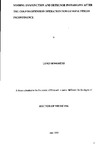VOIDING DYSFUNCTION AND DETRUSOR INSTABILITY AFTER THE COLPOSUSPENSION OPERATION FOR GENUINE STRESS INCONTINENCE
| dc.contributor.author | BOMBIERI, LUIGI | |
| dc.contributor.other | Peninsula Medical School | en_US |
| dc.date.accessioned | 2013-11-01T12:33:50Z | |
| dc.date.available | 2013-11-01T12:33:50Z | |
| dc.date.issued | 1999 | |
| dc.identifier | NOT AVAILABLE | en_US |
| dc.identifier.uri | http://hdl.handle.net/10026.1/2529 | |
| dc.description.abstract |
Colposuspension is an effective treatment for genuine stress incontinence. Continence is restored by positioning the bladder neck in a fixed and elevated retro-pubic position. Despite a high success rate of up to 90%, post-operative complications occur which may have an adverse effect on quality of life. Voiding difficulties develop in 0-43% of patients and detrusor instability in 2- 25%. This considerable variability is due to differences in definition, the timing of assessment, patient selection, and probably also in surgical technique. The natural history of these complications is not clearly known due to the lack of prospective follow-up studies. There is also general uncertainty with regards to their causes. While retrospective studies have attempted to identify pre-operative risk factors, there are no prospective studies which attempt to correlate the anatomical and functional changes caused by surgery with the development of voiding dysfunction and detrusor instability. This study has investigated prospectively 77 women undergoing the operation of colposuspension in relation to the incidence, natural history and causes of post-operative voiding dysfunction and detrusor instability. The complications were identified and followed-up objectively by means of serial urodynamic studies. Patients were also assessed clinically and using quality of life measures. The development of complications were correlated to a number of anatomical and functional changes caused by surgery. Anatomical changes were identified mainly by imaging the bladder neck with Magnetic Resonance Imaging (MRI). Functional changes were identified using urodynamic studies. Voiding dysfunction after colposuspension was common, with 69% of women requiring a catheter for more than seven days, and 28% for longer than 14 days. Improvement occurred gradually in most cases, with only 7. 7% and 2.5% of them needing catheterization at three months and one year respectively. De novo detrusor instability occurred in 21% of women at three months follow-up, and was symptomatic in 66% of these cases. Objective and subjective resolution was seen in 50% of these at one year follow-up. Quality of life after colposuspension improved in most cases despite the development of these complications, probably due to the resolution of their incontinence. Voiding dysfunction and detrusor instability after colposuspension were found to be multifactorial, due to patient related factors (age and detrusor contractility for voiding dysfunction, and age and a past history of bladder neck surgery for detrusor instability), and to operative factors (amount of bladder neck elevation and urethral compression). These findings might lead to the development of preventative measures. | en_US |
| dc.language.iso | en | en_US |
| dc.publisher | University of Plymouth | en_US |
| dc.title | VOIDING DYSFUNCTION AND DETRUSOR INSTABILITY AFTER THE COLPOSUSPENSION OPERATION FOR GENUINE STRESS INCONTINENCE | en_US |
| dc.type | Thesis | |
| plymouth.version | Full version: final and full version as approved by the examiners at the time of the award of your degree | en_US |
| dc.identifier.doi | http://dx.doi.org/10.24382/4253 | |
| dc.identifier.doi | http://dx.doi.org/10.24382/4253 |
Files in this item
This item appears in the following Collection(s)
-
01 Research Theses Main Collection
Research Theses Main


